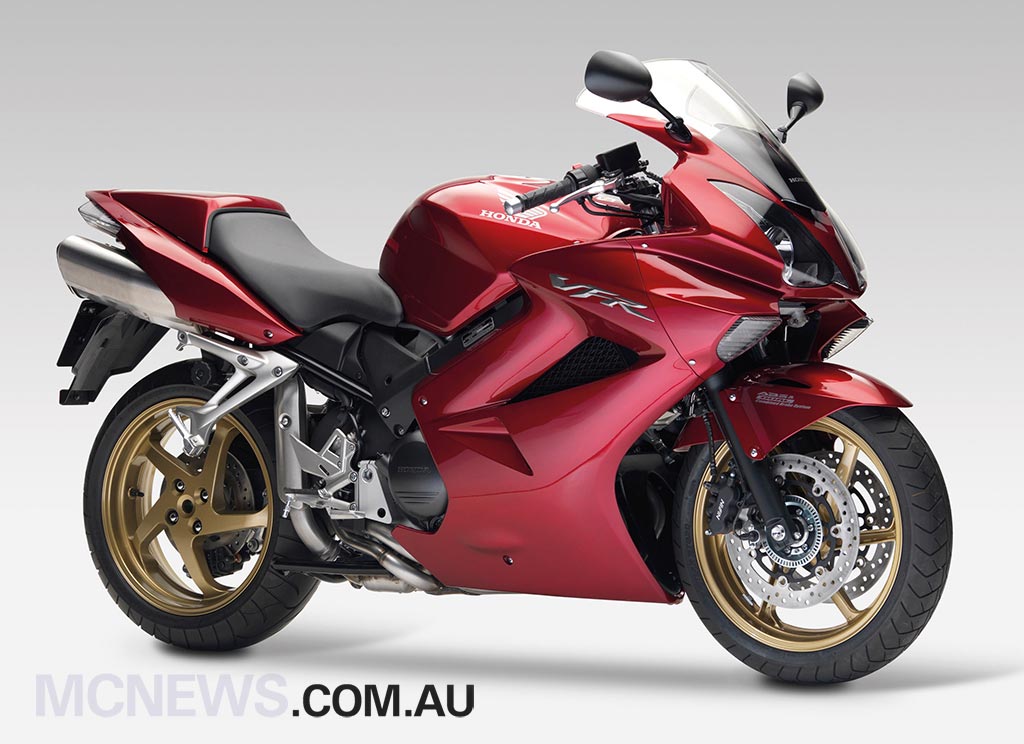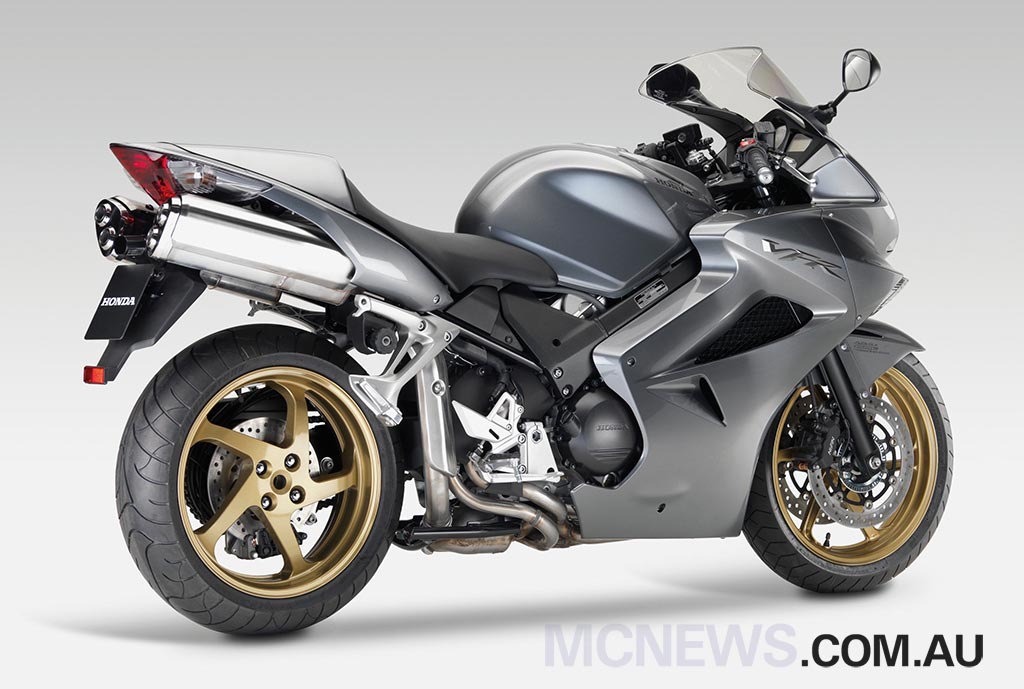Honda first introduced the VFR750 more than 24 years ago and over that time the model has built up an enviable record for great reliability and a wonderful blend of performance and practicality. The move to VFR800 nomenclature happened in 1998 with a rise in capacity to 781cc and the move to an RC45 based PGM-FI electronic fuel injection system.
The model evolved into a rolling showcase for Honda’s adaptation of new technology and has always been well renowned for the evocative v-four exhaust note, particularly when married to the gear driven cams of the pre 2002 models.
Later bikes retained the v-four bark but lost the gear driven whine with a move to VTEC valve gear. Introduced in 2002, the VTEC system features a set of compact, hydraulically actuated lifter sleeves installed inside the inverted buckets of the valve train’s direct-actuation valve lifters, over one intake valve and one exhaust valve in each cylinder. During low-to-midrange operation, the lifter sleeves slide benignly up and down over the tops of the valve stems, allowing only two valves in each cylinder to open.
At 6800 rpm a burst of oil pressure to the lifter sleeves forces their spring-loaded engagement pins to slide across the centre hole and initiate actuation of the remaining two valves of each cylinder. The bike responds with a distinct change in engine note as all four valves come on song which adds excitement to the ride.
In early VTEC models the step in power delivery was a little too pronounced for my liking but the latest model’s transition is much smoother. Early bikes had the VTEC transition set at 6800rpm for both the engaging (accelerating) and disengaging (decelerating) of the extra valves but the latest bike is smarter again with the disengagement set 500rpm lower than the also lower 6,600 engagement point. When reviewing the original VTEC model back in 2002 I noted that when washing off speed to the apex of a turn the disengagement of the extra valves overloaded the front tyre. Now with the 6100rpm disengagement point the VFR800 is much easier to keep spinning above this mark and thus avoid having extra engine braking upset your cornering balance at an inopportune time.
With 107hp at 10500rpm and 80Nm of torque at 8750rpm the VFR800 enjoys a good rev. The power delivery off the bottom is nothing to be sneezed at though and the VFR800 has a decent mid-range before heading into a free revving top end. The engine is only 781cc and thus does not have the huge bottom end grunt of much larger bikes. No amount of technology can beat cubic capacity on that score. Throughout the 800cc era there has not been any claimed rise in power and a pre VTEC (98-01) machine has just as much urge up top as the latest VFR800.
An ultra smooth six-speed gearbox complements the sophisticated fuel-injected engine and the two work seamlessly together to provide reasonably strong drive at any road speed. A three stage damper on the clutch ensures shifting is smooth and helps make the VFR800 a great bike around town.
Braking performance is exceptional despite Australia not receiving the ABS variant of the VFR800. So instead of having a DCBS-ABS we just get the DCBS, one less acronym to worry about.
The VFR’s front brake lever operates the two outer pistons of the left-side front caliper and all three pistons of the right-side caliper, as well as the centre piston of the rear brake caliper. The foot brake actuates two rear brake caliper pistons, but only the one centre piston of the left front caliper. The balance of braking force is administered through a direct-side proportional control valve (PCV) mounted inline between the foot brake master cylinder and the rear caliper.
During light applications of the foot brake most of the actual braking force is applied at the rear wheel, with only the slightest amount of front brake input at the one left-side caliper providing a steadying influence on the suspension. However, this balance of operation changes in response to strong pedal operation, in which case the system adjusts for an optimal balance of front and rear braking forces.
Taken together, these two brake operation scenarios provide a more aggressive distribution of braking forces that enhance braking confidence for a wider range of riders and skill levels. Put simply, the VFR800 brakes are excellent, although the lack of optional ABS in Australia is somewhat of a concern and many riders will never be convinced of the benefits of a linked braking system.
The VFR800 has always been a surefooted and stable handler. 43mm preload adjustable forks are well matched to a preload and rebound damping adjustable rear shock. The machine responds quite well to a little firming up at both ends. If buying secondhand a visit to a reputable suspension tuner for tailored spring and damping rates works wonders and can really sharpen the VFR’s edge.
Comfort was high on the list of design parameters for the VFR800. Even the pillion passenger is well looked after with reasonable leg room and generous seat padding. Wind and weather protection is not quite full dress tourer standard but the VFR800 is a damn sight more accommodating than a pure sportsbike.
A 22 litre fuel tank gives the VFR800 a touring range in excess of 300km no matter how brutal you are with the twist-grip. 400km is achievable at steady highway speeds.
Sliding into place over the tail of the seat when not carrying a pillion is a colour matched seat cowl. The high mount mufflers rob the bike of any under-seat storage space but do allow the optional integrated panniers to sit closer to the bike. A 45 litre top box is also available, as is a taller screen. Unfortunately these accessories that give the VFR800 ultimate practicality come at a significant cost. The full luggage kit will set you back well over $3000.
On the positive side of the coin in regards to pricing however is a recent drop in the retail price of the VFR800 from $15,990 down to a very reasonable $13,990.
The VFR800 is a highly accomplished machine that goes about its business with a level of technical sophistication and polish that few bikes can match. If you can only afford one motorcycle to do everything then the VFR800 is still one of the smartest choices around. The recently announced $2000 saving is extremely significant and now positions the VFR800 as probably the best bang for buck motorcycle on the Australian market.

























